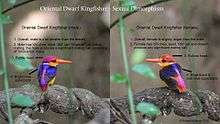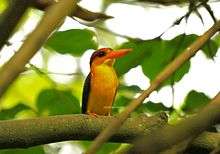Oriental dwarf kingfisher
| Oriental dwarf kingfisher | |
|---|---|
_Photograph_by_Shantanu_Kuveskar.jpg) | |
| Ceyx erithaca with frog kill
from Mangaon, Maharashtra, India | |
| Scientific classification | |
| Kingdom: | Animalia |
| Phylum: | Chordata |
| Class: | Aves |
| Order: | Coraciiformes |
| Family: | Alcedinidae |
| Subfamily: | Alcedininae |
| Genus: | Ceyx |
| Species: | C. erithaca |
| Binomial name | |
| Ceyx erithaca[2] | |
| Synonyms | |
| |


The Oriental dwarf kingfisher (Ceyx erithaca), also known as the black-backed kingfisher or three-toed kingfisher, is a species of bird in the family Alcedinidae.[3] A widespread resident of lowland forest, it is endemic across much of the Indian subcontinent and Southeast Asia. It is found in Bangladesh, Bhutan, Brunei, Cambodia, India, Indonesia, Laos, Malaysia, Myanmar, Singapore, Sri Lanka, and Thailand.
This is a small, red and yellow kingfisher, averaging 13 cm (5.1 in) in length, yellow underparts with glowing bluish-black upperparts.
Habitat
The preferred habitat is small streams in densely shaded forests.[4]
Breeding
It begins to breed with the onset of the southwest monsoon in June. The nest is a horizontal tunnel up to a metre in length. The clutch of four or five eggs hatches in 17 days with both the male and female incubating. The birds fledge after 20 days and a second brood may be raised if the first fails. The young are fed with geckos, skinks, crabs, snails, frogs, crickets, and dragonflies.[5] The rufous-backed kingfisher is sometimes considered a subspecies.
References
- ↑ BirdLife International (2012). "Ceyx erithaca". IUCN Red List of Threatened Species. Version 2012.1. International Union for Conservation of Nature. Retrieved July 16, 2012.
- ↑ David N & Gosselin M. 2000. "The supposed significance of originally capitalized species-group names." BBOC. 120(4):262 note that erithaca is the correct ending but erithacus is claimed to be correct in Handbook of the Birds of the World
- ↑ Ali, S. (1993). The Book of Indian Birds. Bombay: Bombay Natural History Society. ISBN 0195637313.
- ↑ Meyer de Schauenesee; Rodolphe & S D Ripley (1939). "Zoological results of the George Vanderbilt Sumatran expedition, 1936-1939. Part 3- Birds from Nias Island". 91. Proceedings of the Academy of Natural Sciences: 399–414.
- ↑ Palkar, SB; Katdar VD; Lovalekar RJ; Mone RV & VV Joshi (2009). Breeding biology of Oriental Dwarf Kingfisher Ceyx erythaca. 4. Indian Birds. pp. 98–103.
